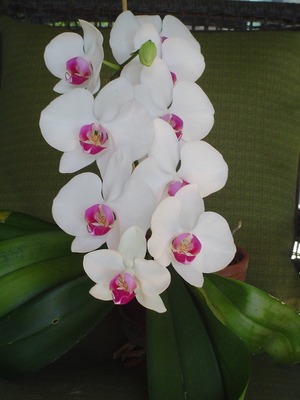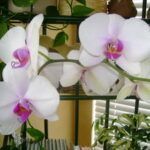I did not title this article, “How to Grow Orchids,” because I do not know how you would grow orchids. Over the past four years, as I have acquired a dozen orchids, I have tended to them with intuition and insight, based on my experience with other plants, not with a lot of research and science about orchids. If it’s science you want, I suggest you start with the Wikipedia article on “Orchidaceae,” that is, the orchid family (here), which has plenty of links for you to follow.
Orchids: Location, location, location
The key to my good luck with orchids (and it is luck, not success earned by work or knowledge) is that I live in central Florida, halfway between Tampa and Orlando, in a semi-tropical climate where orchids grow wild, and where my orchids can stay outside except for a few nights a year.
Then, I live in a house that has a screened porch along its eastern side, where my orchids hang out. So, they get morning sun, although the porch is wide enough that they do not get direct sun. Also, they are away from a door that might open and blast them with air-conditioned air.
Orchids: In and out
Since orchids depend upon a humid environment, I cannot imagine trying to grow them inside, either when heat or air-conditioning is needed. I have heard of people keeping trays with water in them under their indoor orchids. Even with my orchids outside, I spray them during dry spells.
For a few nights a year, I have to bring my orchids indoors, when the temperature drops below freezing. Although some orchids live above the Arctic Circle, I am not taking a chance with mine. When I bring them inside, I put them into the tub in the tub-and-shower combination in my bathroom. Personal hygiene gets exotic, since when I shower, I have to tiptoe through the orchids, with the inevitable parrot on my shoulder (more).
Once, as I’ve written in another article, things got even more exotic when I unintentionally brought a little lizard into the bathroom with the orchids (here).
Orchids: A plant’s pot is its castle
Some orchids, then, do not have a castle, because they are grown without pots. Some are mounted on boards or hang with roots bare. When I bought mine, they were growing in pots, and I have kept them in pots. Orchids need special pots called, to no one’s surprise, “orchid pots.” These are clay pots that, besides the drainage hole in the bottom have three or four slits around the side of the pot.
Orchids: No dirt, please! We’re orchids!
Although some orchids (called terrestrial orchids) grow in soil, most do not. Some, as I have mentioned, grow with their roots bare. Most orchids grown in pots need a special orchid medium, which is made up of chunks of wood. In fact, if I had hundreds of orchids, instead of buying little bags of “orchid media,” I would buy simple mulch. It is not unusual when you purchase an orchid to find that about half the pot is full of Styrofoam “peanuts.”
The medium does not provide anything to the plant except support. I try to remember to repot (and discard the old medium) once a year. If I do not remember, well, the Orchid Police have not busted me yet.
Orchids: Watering (no wet feet)
I have not read much about orchids, but anytime I do read anything, I inevitably come across the line, “Orchids do not like to get their feet wet.” So, although orchids – like all plants – need water, they need it on their own terms. My orchids grow in chunks of wood and Styrofoam in “orchid pots” with a drainage hole in the bottom and drainage slots on the side.
I water my orchids once a week. I put the pot into an old cook pot big enough to accommodate it, and I pour water onto potting mix until the cook pot fills up. Then, I let the plant sit there for about ten or fifteen minutes. If I am feeling especially dedicated, then I will scoop some water out of the cook pot and pour it back into the orchid pot.
Since the potting mix does not hold water well, I want to make sure that it and the roots of the plant are soaked. Then, I lift out the pot and drain the excess liquid.
By the way, orchids do not have a natural seven-day cycle to require watering once a week. That simply makes it easier for me to remember when to water them.
Orchids: Feed me!
Obviously a mix of wood and Styrofoam does not provide much in the way of nutrition. So, it is important to feed your orchids. (At least, they aren’t as demanding – of human sacrifice – as “Audrey II” in Little Shop of Horrors.) I bought a generic “orchid food” (at the grocery store). It seemed fairly expensive, but after four years, the container is not half empty. Again, if I had hundreds of orchids, I am sure I would look for a cheaper alternative.
The directions call for dissolving the fertilizer in lukewarm water. I do that, and then I water as I have explained above.
Orchids: Spare the rod, and spoil the orchid
All plants have some sort of yearly rhythm of growth and rest, of plenty and privation. I decided to provide that sort of cycle for my orchids – and to remind them who the boss is. So, from Halloween until Presidents’ Day (just because those are easy days to remember), I do not feed my orchids, and I water them only every other week (unless they are in my bathroom because of cold weather).
As much as we enjoy their flowers, we may forget that our plants (orchids and others) are not blooming to please us. They are blooming to reproduce, to carry on their species. In other words, we are looking at genitals. Of course, they need a level of nutrition and health to reproduce, but they sometimes they need a threat to their existence to make them bloom.
Orchids: Talk to us
OK, I confess, I talk to my orchids. In the evenings, we can often hear cows mooing in the distance. If the orchids have been lazy about blooming, I tell them I am going to feed them to the cows.
Seriously, with a dozen orchids, and with some of them blooming twice a year (and at least one blooming three times a year), I usually have at least one orchid blooming at all times, and the blooms may last a couple of months or more.
My neighbor has a bizarre orchid with a flower that looks like a deranged starfish. Whenever it blooms, she calls me, and I go over to enjoy it, because it only lasts two days.
Orchids: Don’t give us to sick people
Plants are at their most vulnerable when they are blooming, and that’s the very time we take them out of the environment they’re accustomed to and send them to someone who is sick, so that on top of everything else, the caregiver has to take care of a plant.
When you first get an orchid, don’t worry if the flowers fall off. That’s to be expected. It went through a traumatic change at a bad time (when it was blooming).
If the leaves fall off, don’t worry. That happens. But, if a leaf starts to die, do not cut if off. (This advice is good for almost any plants.) Let it dry up and die on the plant, which will absorb the nutrients from the leaf. (Think of this the next time you want to preserve an amaryllis.)
Orchids: Adopting orchids
About four years ago, I was walking through a local farmers’ market, where I saw a stand with some orchid plants, in bloom, for five dollars each. Five dollars? OK, I could deal with that, and I brought my first orchid (currently blooming; see the photo) home.
My neighbor (who has had orchids longer than I have) prefers to buy little orchids that are years away from blooming. She likes to bring them up and be surprised by how they turn out.
Most orchids have to be several years old before they bloom. If you consider how much time and care an orchid plant takes, you realize that even with a fairly high price, an orchid plant is quite a bargain.
My oldest orchid has been with me for four years, and it is still going strong. So, I think I shall stick with my program. I buy orchids that are in bloom, but I look for a plant that still has most of its flowers in bud. That way, I’ll have longer to enjoy the first flowering.
Orchids: Making babies
Somehow, orchids in the wild manage to do their thing and make little orchids. For orchid enthusiasts in their own homes, propagating orchids is almost impossible.
In cultivation, propagating orchids by seed is an incredibly complex process, beginning with the actual mating, bringing male and female cells together (involving surgical gloves and masks, brushes, and more patience than I have) and going on to sprouting the seed.
Orchids can be propagated in other ways. Some orchids grow in clumps, which can be separated. But, separating the clump weakens it. Some orchids produce keikis, little orchid clones that grow from nodes in the stem. These can be separated, although I have not done so with my one plant that unexpectedly produced keikis.
For me, human sexuality is confusing enough. I’ll just enjoy my orchids, turn my head at the appropriate times, and, if the need ever arises, I’ll light a cigarette or hand out cigars.
Orchids: So, why do you keep them?
For the flowers, of course, the beautiful flowers, and some of those flowers have beautiful scents that are the envy of the perfume industry (not any of mine). Many orchids can be eaten, and at least one orchid, vanilla is… oh, well, you know about vanilla. I have on more than one occasion been surprised in a Thai restaurant with an orchid flower as a garnish. (Yes, I ate it.)
The number one reason for keeping orchids: for a masochist on a tight budget, it is cheaper than hiring a dominatrix.
Orchids: R-rated trivia
A friend of mine refers to her orchids as her “ladies.” I hated to do it (not really), but I told her, truthfully, that the word “orchid” comes from the Greek word for “testicle.”
Orchids: Share the joy
I am not enough of an “orchid person” to join an orchid society, although such groups exist all over the country. I do enjoy going to orchid shows, looking at plants that I know I do not have the knowledge and patience (and money) to have.
I would like to share the joy a little by saying that this article grew out of a conversation with my friend and fellow AC source, known as Sondra C. Please visit her index page (here) to have some fun and enlightenment from reading her articles.
You may also want to read some more of my articles about plants –
“Both Armies Wear Green” – here
“Have a Blooming Christmas” – here
“How to Grow Beautiful and Exotic Plumeria Flowers” – here
“Meeting Our Plant Neighbors” – here
“More Plant Neighbors ” – here
“Naturally Ravin'” – here
“Why Your Garden Didn’t Produce Many Tomatoes” – here





